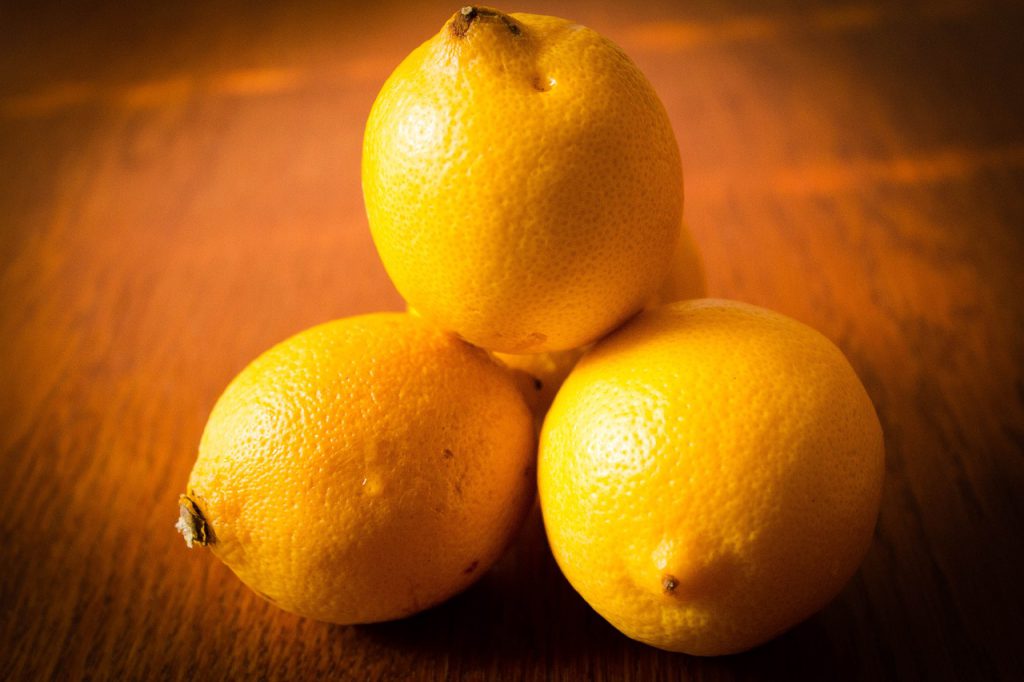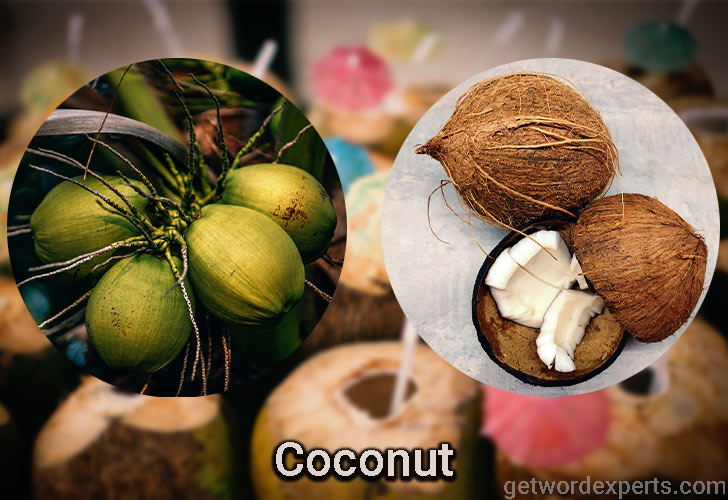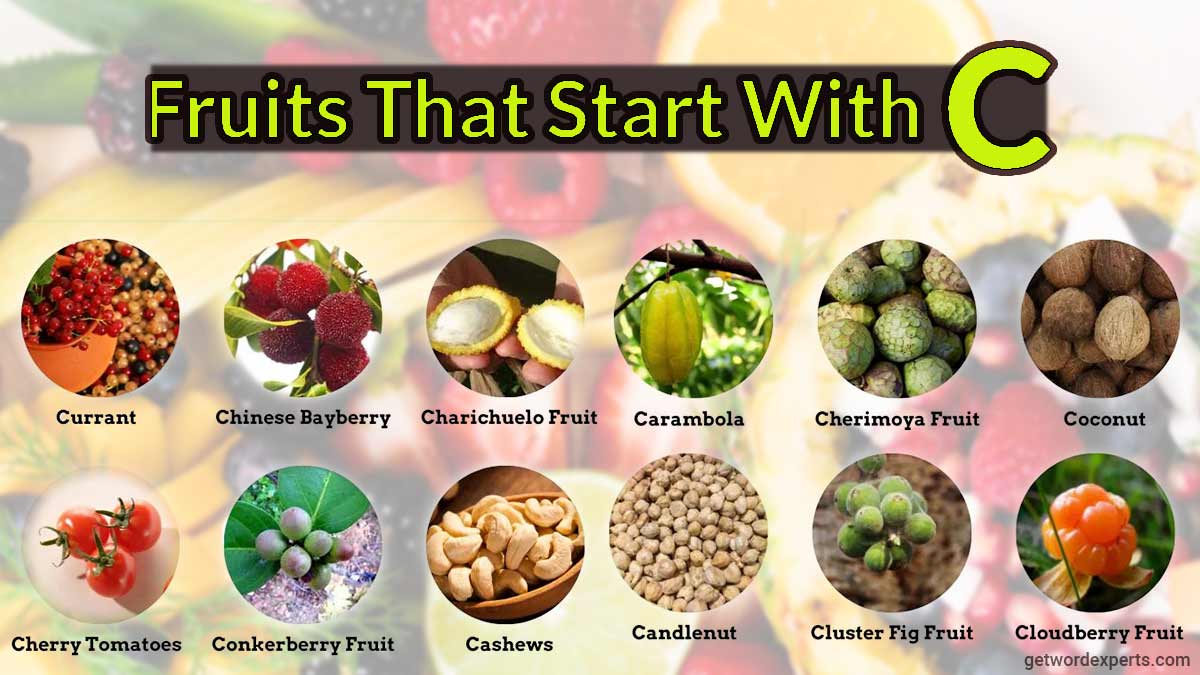Get ready to freshen up your fruit knowledge! Are you curious about fruits that start with C? From familiar fruits you’ve seen in your local market to exotic ones found in far-off landscapes, we’re going to give you a virtual tour of the wonderful world of ‘C’ fruits. Stick with us, and find your next favorite fruit right here.
Here’s a list of both familiar and also lesser-known fruits that start with C.
Calamondin:
A small sour orange is widely domesticated throughout the Philippines. The fruits are often used in Filipino cuisine, either ingested or as a consistent flavor in dishes.
Cape Gooseberry:
This fruit, known as Ahuacatli in its ancestral home of Peru, is enveloped in an adorable lantern-like husk. The sweetness of a tomato kissed with a refreshing pineapple tang is a versatile fruit capable of enhancing salads, salsa, desserts, and cocktails.
Cantaloupes:

These tempting orbs of sweetness, “Cantaloupes,” emerge from the melon family, enriching our summer plates and brunch mixes with their luscious scented pieces, a nutritional plus being Vitamins A and C.
Calville Blanc d’hiver:
A rare French apple variety cherished by leading chefs for its exceptional VItamin C content and balanced sweet-tart flavor. A star ingredient in traditional French desserts, it exhibits an attractive lumpy yet voluptuous exterior.
Capsicum (Peppers):

Predictably unpredictable with a prismatic presence of vivid hues. Capsicum boosts your salads, completes a stir-fry, and injects taste and visual appeal. Ready for the ‘heat,’ they turn things up.
Carpobrotus:
For a sneak exotic-fruity experience from South Africa, just dive among “Carpobrotuses.” Touched by the sun’s bliss, their beautiful clustering arrays gift wild bites and home remedies with a succulent slightly sour charm.
Cashews:

Emerging from the bottom of a bell-shaped fruit, the cashew nut we eat is just one product of this fascinating tree. The never-looking fruit also called the cashew apple, is an exotic treat with a sweetness that balances its astringent taste.
Cattley Guava:

This tropical delight is better known as Strawberry Guava because of its strawberry-like aromas. It is made into juices and jellies that spirit barbeque evenings.
Cantaloupe Charentais:
Cantaloupe Charentais, named after the French town of ‘Charentais,’ delights with remarkable tenderness. Its fragrant sweetness evokes a sense of semi-sweet sophistication
Caimito (star apple):

Caimito entreats captivation by seeing in cross-section revealing why it’s alternately named a “star apple,” coaxing urban dietary platters with characteristic health benefits like antioxidants.
Camu Camu:

Another less known fruits that start with c.These vibrant, cherry-like berries, native to the Amazon rainforest, repackage your Vitamin C fixture. They feature heavily in powered superfood conversations and are typically dropped into smoothies or desserts.
California Prunes (Dried Plums):

Dried fruits are another fruit on our list of fruits that start with C. They offer convenience and nutrition, making them versatile additions to various dishes. Their natural sweetness enhances the flavor of both sweet and savory recipes, and their presence in homes symbolizes a longstanding tradition of healthy eating. So, next time you’re cooking or snacking, consider incorporating these delicious dried fruits!
Calamondin (Citrofortunella microcarpa):

This splendid fusion of wild mandarin orange and kumquat brings zesty flavors to Philippine cuisine. Its tangy notes elevate dishes, from soups to sauces, leaving a memorable impression on every meal.
Ceylon Gooseberry:
Predominantly grown and relished in South Asia, Ceylon Gooseberry, locally revered as ‘Ketembilla’, breaks in your mouth with an unexpectedly seedy texture that’s intriguingly edgy-sweet.
Chayote:

Also known as vegetable pear, Chayote is native to Mesoamerica. This wrinkly-pear-shaped fruit has a mild, crisp flesh that can star in both savory and sweet dishes. Stuffed, baked, fried, or raw in salads – the possibilities attached to a Chayote are also complemented by rich nutritional profiles like potassium, Vitamin C, and fiber.
Cherries:

Jewel-like cherries bring tart-sweet juiciness waiting to burst forth during sun-soaked summer months. They facilitate stand-alone snacking, mood-defining cordial infusions, or dreamy contributions to a succulent pie.
Cherry Plums:
An adorable hybrid of cherry and plum. They fit perfectly in the palm of the hand and burst into vibrant colors like little summer bombs. When ripe, they offer a sweet, slightly aromatic flavor that delights you. Enjoy them as a decorative addition to snacks, drinks, or even a tartine spread.
Chow-Chow (Chayote):
Chow-Chow, also known as Chayote, resembles a pear wearing a slightly prickly coat. Despite its vegetable-like appearance, it’s technically a fruit. Used in various cuisines worldwide, it offers mildly nutty, crisp bites and adds succulent texture to salads and side dishes.
Chilean Guava:
Despite its name, Chilean Guava(Ugni molinae) tastes like a wild strawberry and is celebrated throughout Patagonia in both sweet and savory dishes.
Christmas Melon:
A winter gem with sweet, snowy-white pulp that’s perfect for holiday gatherings. Whether sliced chilled for a refreshing snack or mixed into cocktails, its jam-like sweetness adds a cozy touch to festive evenings. With hints of Christmas charm, it’s sure to become a seasonal favorite!
Cinnamon Apples:
Let’s talk cinnamon apples! Imagine biting into a slice—crispy, juicy, with that cozy cinnamon kick. They’re like a warm hug on a chilly day, whether you’re snacking solo or pairing them with a scoop of vanilla ice cream for dessert. Trust me, they’re pure autumn bliss in every bite!
Citron:

A large, thick-skinned citrus fruit with very little pulp or juice, the zest is very aromatic and flavor-intense, making it suitable for multiple uses in dishes, desserts, and candies.
Citrus:

Citrus are well known fruits that start with c, these fruits come in orbs of gleaming textures soft or rugged. From the tangy scene-stealing superstars like oranges to the subtly sour after-tonal beauties like Clementine, these fruits are cherished worldwide for flavor, nutritional vigor, and culinary potential.
Clethra (Summer Sweet):
With edible, albeit quite tangy fruits that attract local fauna, this plant often graces ornamental gardens for its showy pink-white mid-summer blossoms.
Cloudberry:
The golden-to-orange bite-sized fruit from the cold Nordic mountains can be eaten fresh or often turned into artisanal jelly or liqueur.
Cocona:
A cherry-tomato-like appearance shines bright in colors ranging from yellow to deep orange, and a subtly tart Amazonian delight heralding wonders in salsas, juices, or an experimental ingredient savored for its vivacious chatters of native dietary custom.
Coconuts:

Nothing better conveys tropical essence than coconuts, which provide hydration through their refreshing water, nourishment through their delicious flesh, and numerous health benefits through their oil. Packed with vital nutrients such as potassium, manganese, and copper, coconuts serve not only as a delectable treat but also as a sustainable source of nutrition.
Coconut Apples:
Although not as common as coconuts, Coconut Apples are the spongy and sweetheart of a bright Coconut Palm tree, and they are used in various South-Asian refreshing delicacies.
Comice Pears:
Comice Pears represent the gift of richness garnishing celebratory spreads across winter festivities. Melt-in-your-mouth buttery sweetness and wonderful texture make them a versatile delight beyond being mere bite-sized heart-warmers.
Common medlar (Mespilus germanica):

Seen in Europe and Southwest Asia, this rosette-rounded brownish fruit shares center-stage during winters. Its sweetened fermented cider undertones upon ‘bletting’ (intentional over-ripening) captivate the festive dishes or on their own.
Corbezzolo (Strawberry Tree fruit):
Also known as “Strawberry Tree fruit,” gets its nickname from its strawberry-like outward texture. Its soft pulp discloses flashes of apricot or fig, nutritively hoarding vitamins in forgettable bites.
Cornelian Cherries(Dogwoods):

Picture us gathering around the kitchen, adding these Pomegranate-like beauties to our pie recipe. They arrive just as winter fades, their tart flavor perfect for cozy gatherings and nostalgic moments by the oven.
Crab Apples:

With their charmingly rustic appearance, crab apples embody the essence of springtime. When these little orbs reach culinary perfection, they transform into a delightful treat, perfect for crafting flavorful jellies, jams, and more. They’re not just fruits – they’re memories etched in every bite.
Crenshaw Melon:

This sweet late-summer melon hybrid is a cross between ‘Caspian’ and ‘Persian’ melons. With its dense, salmon-colored flesh, the Crenshaw melon offers a smooth, vividly sweet flavor that is interesting on its own or blitzed in smoothies.
Crossberry/ Grewia occidentalis:
Another fruit from the list “fruits that start with c” also known as Dwart’s Hackberry, this fruit is slightly similar to mini berries but has a unique four-lobed shape. It offers sweet and chewy nourishment and is frequently prepared into ferments, syrups, and foraged sweets.
Crowberry:

These tough little berries are real survivors, thriving in harsh climates like the Arctic tundra and lofty Alpine moors. While they may be a bit tart at first, their flavor transforms beautifully when slow-cooked into vibrant jellies or glazes. Perfect for adding a touch of decadence to your favorite classic dishes.
Cucumbers:

Although cucumbers are not typically considered fruits, they are indeed fruits and a versatile addition to any kitchen. Cucumbers are known for their cool, crisp thickness and subtly melon-tinged taste—perfect for salads, refreshing drinks, or on their own with a dash of salt.
Cugua:
A tropical fruit found in Central and South America, cugua lends a sweet-tart flavor used traditionally for various medicinal purposes.
Cupuacu:
Closely related to the Cacao tree, this Amazonian superstar offers large oblong, pulpy fruits that serve as resourceful products—from tart to velveteen jam or add-ons to a tropical morning breakfast, masking products also harp on its hydration properties.
Currants:

Currants are tiny, jewel-like berries packed with a tart flavour. They come in black, red, and white varieties and are a key element in British culinary traditions, adding a sweet-sour punch to pastries, scones, and sauces.
Custard Apples:

With a lumpy exterior that liberalizes a subtly sweet, creamy custard-like flesh, it’s also called ‘Sitaphal’ in India. They provide a divine eating experience solo or in blending into a traditional Indian milk dessert.
Cyrilla racemiflora (Swamp Titi):
Fruits are small and bird-welcoming homes with juicy pulp when they attain maturity. Surprisingly frost-hardy, they transport us back to ornamental semblance, saying you can relish them when your family is out in nature’s lap, hiking or bird-watching.
Explore the delightful world of fruits that start with C, from everyday choices to rare finds. Whether you’re adding flavor to your meals or simply curious, this guide offers fresh inspiration for your next culinary adventure. Next time you’re at the market, try a new ‘C’ fruit and discover the unique tastes and benefits each one brings. There’s always something new to explore—start your fruity journey today!

